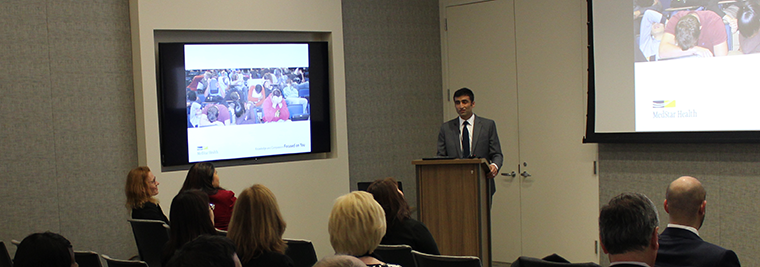Research undertaken by a MedStar Health Teaching Scholar sought to increase resident engagement with lectures on anesthesiology through understanding educational needs for a diverse group of learners. Anesthesiology residency programs have implemented uniform lecture series for all trainees. All residents, regardless of level or rotation, attend the same early morning lecture. Given this structure, it is likely that the topic of the lecture will not apply to the learning rotation or focus of the attendees. The goal of this intervention was to use technology to target learners in a more personalized way, based on the patients they are seeing that day.
“Enabling “Push Notifications” in Anesthesiology Training”, led by Sumeet Gopwani, MD sought to use a targeting approach with technology to increase resident reading and create a facilitative teaching tool. In order to encourage learning, it was important to understand residents to be adult learners and the importance of teaching that would be relevant to their experiences. For this group of learners, Just In Time methodologies such as personalized web-based resources were ideal. Residents read 4 hours/week on average and are most motivated to read for their clinical cases.
The study included 10 residents that were randomized to be enrolled in a directed reading intervention for 2 months. The resident reading time was compared from their baseline when they were enrolled in the program and how the residents’ reading changed during the study period. The effect on teaching evaluations was also measured. Baseline resident reading levels were 6.5 hours/week. During the first phase of the study, residents in the directed reading group increased their reading by 2 hours/week, while the control group decreased reading by 0.5 hours/week.
Direct reading articles were sent to faculty to use a facilitative teaching tool but the analysis concluded that only 15% of the time did faculty discuss the articles with the residents. During the second phase of the study, residents in the control group had essentially stopped reading altogether. However, residents in the directed reading program continued to read at their baseline levels. The research showed that technological feasibility for personalized, automated, case-based, directed reading can be established. Also, using the adult learning theory and an understanding of residents’ motivation for reading, the direct reading program showed significant increase in resident reading. While faculty did not regularly use the program as a facilitative teaching tool, the results show a large effect on teaching evaluations.
The research team believes next steps will be to evaluate why the directed reading program did not fully succeed as a facilitative teaching tool. They would like to consider the faculty user experience and layering their teaching preferences into the targeting. Also, there is a plan to expand the project to additional anesthesiology programs.
This research was presented as part of the MedStar Health Teaching and Research Scholars Capstone event, which culminates both the two-year programs.

